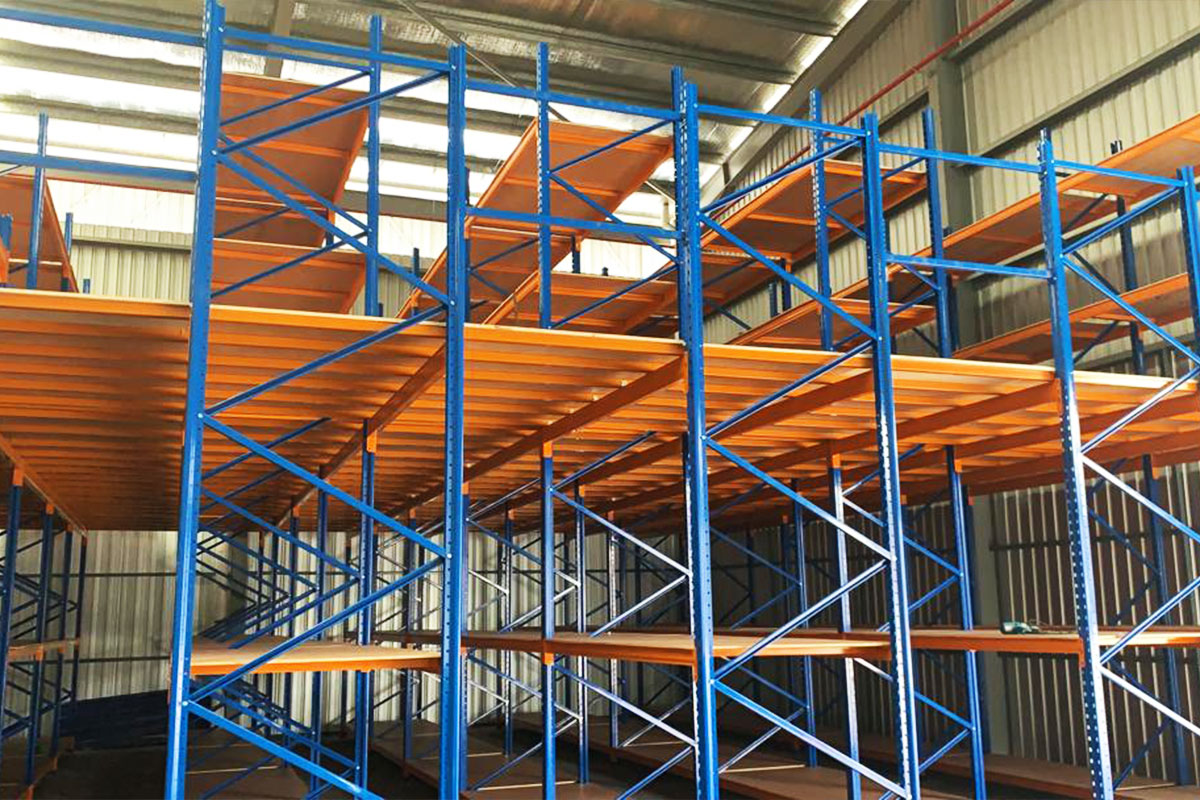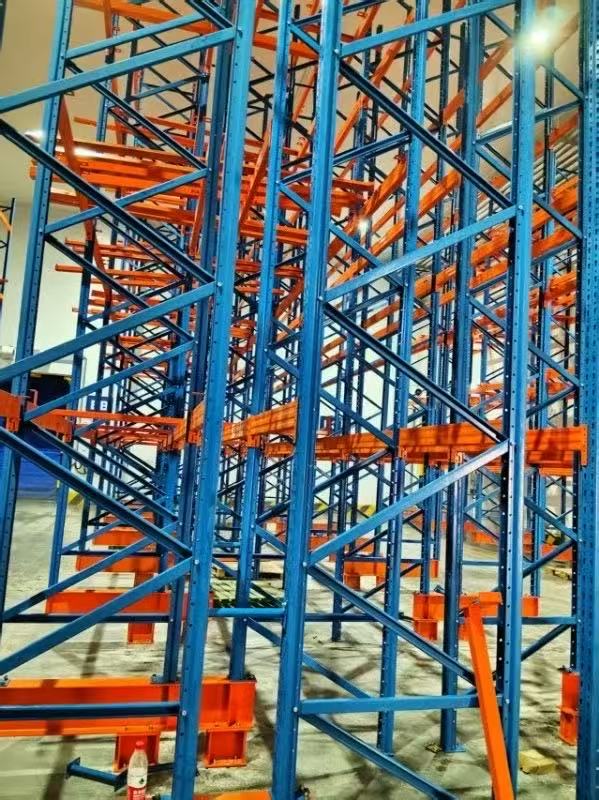When we talk about optimizing storage and logistics, the conversation inevitably turns to pallet racking in warehouse environments. This system is the fundamental framework, the literal backbone, of most modern storage facilities. At its core, pallet racking in warehouse settings refers to the material handling storage aid system designed to store materials on pallets (or "skids"). Without an effective pallet racking system, warehouses would descend into chaos, struggling with inefficient use of space, difficult inventory access, and compromised safety.
The basic principle is simple: it provides a structured way to stack goods vertically and horizontally, maximizing the available cubic space of a facility. From receiving and storage to picking and shipping, a well-planned pallet racking system ensures that every step of the logistics chain flows smoothly. It's not just about storing more; it's about storing smarter, enabling faster order fulfillment, and maintaining a safe work environment for personnel and products alike.

A pallet racking system is far more than a collection of steel beams. It is a sophisticated, engineered solution tailored to the specific needs of a warehouse's inventory, workflow, and building characteristics. The primary goal of any pallet racking system is to provide high-density storage while ensuring direct access to every single pallet load, a concept known as 100% selectivity.
The design and implementation of a pallet racking system involve careful consideration of several factors:
Inventory Characteristics: The size, weight, shape, and turnover rate (how quickly items sell and are replaced) of the products being stored are paramount. Fast-moving goods might be placed in easily accessible areas, while slower-moving inventory can be stored higher up.
Forklift Compatibility: The type of material handling equipment (e.g., counterbalance forklifts, narrow-aisle reach trucks, order pickers) used in the facility directly determines the kind of pallet racking system that can be installed. Aisle width is a critical factor here.
Building Constraints: The height of the building, floor flatness, and column locations all influence the design and maximum height of the racking.
Investing in the right pallet racking system is a strategic decision that impacts a company's operational efficiency, storage capacity, and ultimately, its bottom line.
While configurations vary, the typical pallet rack is built from several key structural components. Understanding these parts is essential for discussing capacity, safety, and configuration options.
Upright Frames: These are the vertical components that form the sides of the pallet rack. They are typically constructed from rolled steel and feature a series of holes or hooks for attaching beams at various heights. The height, depth, and thickness of the upright frames determine the overall strength and load capacity of the system.
Beams: These horizontal components span between two upright frames and provide the support for the pallets. Beams are equipped with hooks or bolts that lock into the uprights. They are rated for specific maximum loads and are available in various lengths and strengths.
Wire Mesh Decking or Beams: For safety and support, decks are often placed across the beams. Wire mesh decking prevents pallets from falling through and helps protect against fire by preventing the vertical spread of flames. It also provides a safer surface for workers to walk on when necessary.
Row Spacers and Braces: These components connect adjacent rows of back-to-back racking, adding stability and integrity to the entire structure. They ensure the pallet racking system can withstand seismic activity and the occasional impact from forklifts.
Shims: Used to level the pallet rack on an uneven floor, shims are critical for ensuring the load is distributed evenly and the structure remains plumb and secure.
Every component in a pallet rack plays a vital role in the system's overall safety and performance. Regular inspections of these parts are mandatory to identify any damage, such as bent beams or dented uprights, that could compromise the structure's integrity.
The integrity of your entire warehouse operation rests on the quality of your storage system. This makes the choice of pallet racking manufacturers one of the most critical decisions a warehouse manager or business owner can make. Not all manufacturers are created equal; the quality of the steel, the precision of the engineering, and the adherence to strict safety standards vary significantly across the industry.
When evaluating pallet racking manufacturers, consider the following criteria:
Reputation and Experience: Look for established manufacturers with a long history in the industry. A proven track record is a strong indicator of reliability and product quality.
Compliance and Certification: Reputable manufacturers design and test their systems to meet or exceed stringent industry standards and local safety regulations. Ensure their products are certified accordingly.
Engineering Support: Top-tier pallet racking manufacturers don't just sell beams and frames; they provide expert engineering services. They should offer layout design, load capacity calculations, and seismic evaluations to ensure your system is optimized for your specific needs and is completely safe.
Product Range: The best manufacturers offer a wide variety of pallet racking system types (selective, drive-in, push-back, etc.) and a comprehensive range of components and accessories. This allows for a customized solution and simplifies future expansion or reconfiguration.
Warranty and Support: A strong warranty protects your investment. Furthermore, assess the manufacturer's ability to provide ongoing support, replacement parts, and technical assistance long after the initial sale.
Choosing a manufacturer known for quality and service may involve a higher upfront cost, but it pays dividends in safety, durability, and long-term performance, preventing costly downtime and accidents.
While manufacturers create the components, pallet racking suppliers and distributors are the vital link that connects these products to the end-user. A supplier is often your single point of contact for everything from initial consultation and system design to installation, inspection, and maintenance.
The role of pallet racking suppliers encompasses much more than simply taking an order. Their value lies in:
Consultation and System Design: Good suppliers have experienced consultants who can analyze your storage needs, inventory profile, and operational workflow to recommend the most efficient and cost-effective pallet racking system. They use advanced software to create detailed layout plans that maximize your storage density.
Project Management: They coordinate the entire process, from sourcing the correct components from manufacturers to managing the logistics of delivery and coordinating with certified installation crews.
Installation Services: Professional installation is non-negotiable for safety and performance. Reputable pallet racking suppliers employ or partner with trained and certified installers who assemble the system according to the manufacturer's specifications and engineering plans.
Equipment and Accessories: Beyond the racking itself, suppliers often provide the necessary material handling equipment (like forklifts designed for narrow aisles) and essential safety accessories, including rack guards, column protectors, and safety netting.
Ongoing Service: The relationship shouldn't end after installation. The best pallet racking suppliers offer ongoing services such as routine safety inspections, damage assessments, repair services, and supplying parts for system expansion or reconfiguration.
Building a strong partnership with a knowledgeable and reliable supplier is just as important as choosing a quality manufacturer. They are your local experts and first line of support for maintaining an efficient and safe warehouse.

The term "pallet racking in warehouse" is not one-size-fits-all. Several distinct types of systems have been developed to address different storage challenges. Selecting the right type is crucial for maximizing efficiency.
Selective Racking: This is the most common and versatile type of pallet racking system. It allows direct, immediate access to every pallet located in the system, making it ideal for warehouses with a high number of SKUs. It provides 100% selectivity and is compatible with a wide range of forklift trucks.
Drive-In/Drive-Through Racking: This is a high-density storage system where the forklift drives directly into the rack structure to place or retrieve pallets. It sacrifices selectivity for density. Drive-in racking (last-in, first-out) is typically used for bulk storage of similar products with low turnover. Drive-through racking (first-in, first-out) allows access from both ends.
Push-Back Racking: Another high-density system, push-back racking, operates on a Last-In, First-Out (LIFO) basis. Pallets are loaded onto wheeled carts that nest on slightly inclined rails. When a new pallet is pushed into a bay, it pushes the existing pallets back. When a pallet is removed, the next one moves forward automatically. It offers a good balance between density and selectivity.
Pallet Flow Racking: This dynamic system uses a "first-in, first-out" (FIFO) inventory method. Pallets are loaded from the rear on a downward sloping track using rollers or wheels. Gravity causes the pallets to flow gently to the front picking face. It is perfect for high-throughput operations with perishable goods or products with expiration dates.
Mobile Racking: This system mounts standard selective racking onto motorized mobile bases that move on tracks embedded in the floor. Only one aisle is opened at a time, drastically increasing storage density by eliminating all but one permanent aisle. It is excellent for cold storage facilities or archives where space is at an absolute premium.
The choice of system depends entirely on your specific application, and a hybrid approach using multiple types is often the most effective solution.
A pallet racking system is a significant investment and a critical piece of workplace infrastructure. Its ongoing safety and performance depend on a rigorous maintenance and inspection regimen. Damage to a pallet rack, however minor it may seem, can significantly reduce its load-bearing capacity and create a serious safety hazard.
Key safety practices include:
Regular Inspections: Implement a schedule for formal inspections by a qualified engineer or trained inspector. Additionally, encourage forklift operators and floor staff to perform daily visual checks and report any damage immediately.
Immediate Repair: Never ignore damage. Have a protocol in place for immediately tagging and offloading a damaged section of racking until it can be properly repaired or replaced by a professional. Most reputable pallet racking suppliers offer emergency repair services.
Proper Loading: Never exceed the specified maximum load capacity for any beam or upright frame. Ensure pallets are properly positioned on the beams and are not overhanging excessively.
Employee Training: Thoroughly train all personnel who work near or operate equipment around the racking. They must understand the importance of careful operation, how to identify potential damage, and the catastrophic consequences of racking collapse.
Use Protective Equipment: Install rack guards (also called column protectors or post protectors) at vulnerable points, such as at the end of aisles or near corners, to absorb the impact from forklifts and prevent damage to the uprights.
A culture of safety, supported by consistent maintenance, protects your employees, your inventory, and your investment in your pallet racking system.
The world of warehouse storage is not static. Pallet racking manufacturers are continuously innovating, driven by the demands of e-commerce, automation, and the need for ever-greater efficiency. We are seeing the integration of pallet racking system designs with advanced technologies like:
Automation: Automated Storage and Retrieval Systems (AS/RS) use robotic cranes that travel within the rack structure to store and retrieve pallets with incredible speed and precision, often in complete darkness. These systems are often integrated with sophisticated warehouse management software (WMS).
IoT Sensors: Sensors can be mounted on racking to monitor load weights, detect impacts, or even track inventory levels in real-time, providing valuable data for optimizing operations.
Advanced Materials and Design: Manufacturers are developing stronger, lighter materials and more refined engineering designs to create racks that can hold more weight, reach greater heights, and fit into increasingly complex warehouse layouts.
The core principle of pallet racking in warehouse operations will remain, but its execution will become smarter, more integrated, and more efficient than ever before.
In conclusion, the humble pallet rack is the unsung hero of the logistics world. From the raw materials sourced from pallet racking manufacturers to the expert advice provided by pallet racking suppliers, every element comes together to form a pallet racking system that is the very foundation of modern commerce. Choosing, installing, and maintaining this system wisely is not just an operational task—it is a strategic imperative for any business that values efficiency, safety, and growth.
 Wechat
Wechat
 Whatsapp
Whatsapp